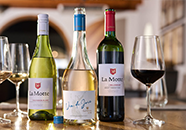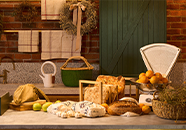
Earlier this year we introduced our 2011 vintage of the La Motte Syrah, previously known as Shiraz. We also explained the reason behind our name change – we wanted the name of the wine to reflect its style, similar to the style of the wines made in France’s Rhône Valley. The 2011 La Motte Syrah is also bottled in a typical Rhône-style bottle. Yes, like the wine itself, the bottles they are bottled in also differ between various wine styles and regions.
Thewinedoctor.com gives a great summary of the different bottle types.

Bordeaux bottles have straight sides and tall shoulders, with dark green glass for the dry red wines of the region, lighter green for the dry whites and, for the sweet whites, clear glass. This bottle shape is widely used in the New World by winemakers bottling Bordeaux varieties, but it is also widely used in Italy, for modern-day Chianti for example, and many other countries.

Burgundy bottles have gently sloping shoulders, with both red and white wines in similar green glass. These are sturdy, heavy bottles, with a slightly fatter girth than other wine bottles – although you may only notice this if stacking them. This shape is also widely used throughout the New World for Chardonnay and Pinot Noir, although it is also used in Italy for Barolo, and for many wines from the Loire, Languedoc and beyond.

Bottles from the Rhône Valley have a similar style to the Burgundy bottle, although the girth may differ slightly; traditionally these bottles were perhaps less fat than those from Burgundy, although that is probably no longer a valid distinction. In addition, some may bear a coat of arms on the neck, particularly those from Châteauneuf du Pape. The traditional Côtes du Rhône bottle is similar in shape, but with more angular sloping shoulders. New World Shiraz may have a similar bottle, but often this is not the case, and again many other regions may also use this style.

The design of the Champagne bottle is born out of necessity as much as style. Thick glass, gently sloping shoulders and a deep punt (the indentation on the underside) are necessary as the pressure inside the bottle is 80-90psi (three times the pressure inside an average car tyre). Likewise, New World fizz producers use the same design.

The slender bottle, narrower than other styles, also much taller, with a very gentle slope to the shoulders and green glass suggests that the wine is either from the Mosel in Germany, or Alsace in France (see below for brown glass). The wine contained may still be one of a wide variety of styles, however, ranging from dry and off-dry, through to lusciously sweet dessert wines. Read the label!

Wines from the Rhine (once traditionally referred to as ‘hock’) spends its life in a bottle similar in shape to the Mosel/Alsace bottle. The main distinguishing feature is the glass, which is traditionally coloured brown. The traditional wine glasses of the Mosel and the Rhine reflect this, having green and brown stems respectively. Once again, however, the style of wine can vary, and a little label knowledge is required.

Many fortified wines, such as Port, Madeira and Sherry, are transported in quite sturdy bottles. The vintage Port bottle may have quite a bulge in the neck, supposedly to help capture the sediment as the aged wine is decanted. Many of these wines, especially if for drinking young, would be sealed with a cork stopper rather than a long cork.

There are no unbreakable rules; this is true particularly when considering the wines of non-classic regions or the New World. Although winemakers may bottle in styles similar to the region that gives them inspiration, there is no requirement to do so. In fact, even with classic regions, almost anything goes, as the wacky, half-melted appearance of the Père Anselme Châteauneuf-du-Pape bottle shows!












